Click here to check out the Backstage Banter for The Divine Sister at Fells Point Corner Theatre!
“…this piece tickles the proverbial funny bone without offending and the story actually isn’t heavy on religion but sending a message of love, faith, and hope.”
Fells Point Corner Theatre
Monthly Archives: November 2016
Review: The Game's Afoot at Spotlighters Theatre
By Jason Crawford Samios-Uy

Running Time: 2 hours and 30 minutes with one 15-minute intermission
When one thinks of the holidays, rarely does one think of a murder-mystery, but Spotlighters Theatre latest offering, Ken Ludwig’s The Game’s Afoot, Directed by Fuzz Roark with Danny Romeo, along with Set Design by Alan Zemla, Lighting Deisign by Al Ramer, and Costume Design by Andrew Malone is a joyful whodunit that is sure to be a pleasing break from the hustle and bustle of this holiday season.

The Cast of The Game’s Afoot at Spotlighters Theatre. Credit: Spotlighters Theatre/Shealyn Jae Photography/shealynjaephotography.com
Set in 1936, this zany story unfolds at the large estate of William Gillette, a famous actor who is known for portraying that well known sleuth, Sherlock Holmes. The problem is, Gillette fancies himself a real life detective and when murder comes to his home, he and his guests (and cast mates from his latest production) work to figure out who the culprit is. Throw in a sharp tongued theatre reviewer and a local constable, the investigation develops with humorous results.

Credit: Spotlighters Theatre/Shealyn Jae Photography/shealynjaephotography.com
Set Design by Alan Zemla is impressive with an attention to detail. Spotlighters is somewhat unique in the fact that practically the entire theatre is used in their sets and this production is no different. It’s already theatre in the round and every corner is utilized, including a large trimmed Christmas tree, a small closet, an entrance/exit to the stage, and… get this… a secret room, which is absolutely ingenious. Taking a moment with the secret room, the door is evening seemingly automatic with the pull of an ornamented rope. Zemla’s detail with the stone work and shiny marble floor is superb and adds value to the production and sets the mood for the piece. Major kudos to Alan Zemla on his brilliant design.
Lighting Design by Al Ramer is appropriate and well planned out, adding to the value of the production. Murder-mysteries rely on precisely timed blackouts and Ramer’s design is on point, adding suspense to the scenes. Spotlighters is a small space but Ramer manages to light it accordingly with a well thought out design.

Melanie Bishop, Ilene Chalmers, and Thom Eric Sinn. Credit: Spotlighters Theatre/Shealyn Jae Photography/shealynjaephotography.com
Costume Design by Andrew Malone is impeccable and he nails the period of the piece, which is the mid-1930s (and one of my favorite eras). Mens fashion hasn’t changed much through the years and a suit is always the norm, but Malone fits his male actors nicely and they seem comfortable as they move about the stage. The ladies fashions are quite a different story. Malone completely captures the essence of the 1936 upper class with flowing, yet form fitting gowns that ooze elegance. All the characters look their part and the period and gives an authenticity to the entire piece. Overall, Malone’s design is stunning and intelligent and is a joy to experience.

Tom Piccin and Ilene Chalmer. Credit: Spotlighters Theatre/Shealyn Jae Photography/shealynjaephotography.com
Direction by veteran Fuzz Roark with Danny Romeo is very good and they give us a charming and entertaining piece. Their vision is strong and through clever blocking in the round and with the talents of the cast, the story is easy to follow throughout. Roark and Romeo keep the action and their actors moving naturally to make sure the entire audience gets attention and doesn’t miss out on any of the story being told. The character work is brilliant and with the guidance of Roark and Romeo, they are fleshed out and authentic. The twist at the end is a bit abrupt and a tad bit confusing, but it is surprising, as intended and you’ll have to check it out to find out what it is! In general, Roark and Romeo did a splendid job with this piece and kept it funny, entertaining, and suspenseful, making for an veritable murder-mystery for the holidays.

Suzanne Hoxsey as Inspector Harriet Goring. Credit: Spotlighters Theatre/Shealyn Jae Photography/shealynjaephotography.com
Moving into the performance aspect of The Game’s Afoot, Suzanne Hoxsey takes on the role of Inspector Harriet Goring, the local constable assigned to check out a mysterious call made to the police station earlier in the evening. The character of Inspector Harriet Goring is supposed to be the “straight-man,” as it were, taking things seriously and trying to solve the mystery. Through this seriousness, the comedy shines through but, frankly, Hoxsey’s performance falls flat for me. She seems as though she’s trying too hard for the laugh but the timing is off and somewhat monotone, cautious delivery loses the comedy. That being said, Hoxsey gives 100% to her performance which is very admirable. She’s de
dicated to the role and sticks with it with confidence and a command of the stage.

Kellie Podsednik, Ilene Chalmers, and Andrew Wilkin. Credit: Spotlighters Theatre/Shealyn Jae Photography/shealynjaephotography.com
Andrew Wilkin tackles the role of Simon Brigh, the younger actor who exudes a certain sleaziness but you can’t figure out just why because he seems like a gentleman but there’s just something about him. Wilken plays that aspect of the role beautifully and he looks the part and plays it confidently but his representation of this character seems to be all in contorted facial expressions. At times, in his intense scenes, he comes off more as a scary deranged clown rather than an upset and angry young actor. His character goes from one end of the spectrum to the other, between a suave demeanor to an angry desperation and both are a bit over the top with no in between. Now, this is not to say his performance is bad, because it is not. He commands the stage easily and his voice resonates throughout the small theatre. He, too, gives 100% to his character and makes choices to allow his character to be easily understood.
Tom Piccin as Felix Geisel does an admirable job as the loyal, laid back best friend and gives a strong performance with very good comedic timing and an urgency that drives his character’s actions. He understands his character and plays him with ease while having great chemistry with his fellow cast mates making for a very enjoyable performance.
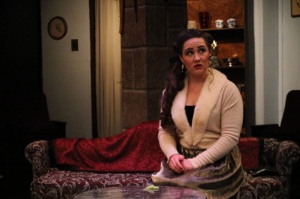
Kellie Podsednik as Aggie Wheeler. Credit: Spotlighters Theatre/Shealyn Jae Photography/shealynjaephotography.com
The role of Aggie Wheeler, the young, impressionable actress is taken on by Kellie Podsednik and her take on this character is thoughtful and entertaining. There may be more to this character than meets the eye and Podsednik plays the role with a natural, innocent air that works well and actually makes her a likable character. Podsednik is comfortable on stage and gives a strong performance that is confident and enjoyable.
Ilene Chalmers takes on the role of Madge Geisel, an old friend who is just as loyal as her husband, Felix. Chalmers plays this role with gusto and gives her all to this character and her dedication pays off as her portrayal is authentic and natural. Madge Geisel is more than an innocent bystander and she likes to get into the heart of the action and Chalmers plays this beautifully. She has a strong command of the stage and is a joy to watch.
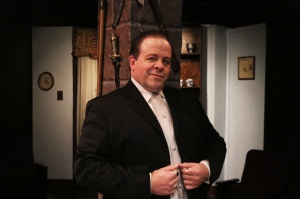
Thom Eric Sinn. Credit: Spotlighters Theatre/Shealyn Jae Photography/shealynjaephotography.com
Thom Eric Sinn plays William Gillette, the leading man who is famous for playing Sherlock Holmes and actually considers himself a brilliant detective and who has gathered these poor souls to his home on Christmas Eve. Sinn has a very strong stage presence and fits nicely into this character. His voice resonates throughout the theatre and he is natural and comfortable in this role. He has great comedic timing and does well with the farce, though his urgency does seem a bit forced at times. Overall, Sinn gives a very strong and entertaining performance.

Penny Nichols as Martha Gillette. Credit: Spotlighters Theatre/Shealyn Jae Photography/shealynjaephotography.com
Martha Gillette, the doting, elderly mother of William Gillette, is played by Penny Nichols and she is beyond charming in this role. At first glance, I didn’t buy the fact that Nichols is playing Sinns mother as she looks entirely too young for the role, but her portrayal of the character just emphasizes her acting skills and she played this part to the hilt. After a few moments, she is totally believable as the mother of Sinn’s character, regardless of looking younger than her character is supposed to be. She has beautiful comedic timing and her asides as she leaves the stage are just as funny as her onstage lines. She is a joy to watch and I hope to see more of her work in the future.

Melanie Bishop as Daria Chase. Credit: Spotlighters Theatre/Shealyn Jae Photography/shealynjaephotography.com
Melanie Bishop as Daria Chase, the cut-throat, acidic theatre reviewer who seems to know the secrets of all the other guests and isn’t afraid to share them, is an absolute highlight of his production giving an outstanding performance. She has the fast talking, quit witted character down pat even using a Katherine Hepburn-esque voice that absolutely fits this character making her more authentic. Her confidence and comfort on stage makes for a superb performance that is not to be missed.
Final thought… The Game’s Afoot at Spotlighters Theatre is a bona fide murder-mystery that will have you laughing and scratching your head, wondering “whodunit?” The performances are strong and the story is entertaining and original making for a fun night of theatre in the midst of the hustle and bustle of the holiday season. Take a break from the craziness and check out this show!
This is what I th
ought of Spotlighters Theatre production of The Game’s Afoot. What did you think? Please feel free to leave a comment!
The Game’s Afoot will play through December 18 at Spotlighters Theatre, 817 St. Paul Street, Baltimore, MD. For Tickets, call the box office at 410-752-1225 or purchase them online.
Review: The Divine Sister at Fells Point Corner Theatre
By Jason Crawford Samios-Uy

Running Time: 2 hours and 10 minutes with one 15-minute intermission
Religion is always a tricky and sometimes touchy subject in the arts, but that’s only when its taken too seriously. The latest offering from Fells Point Corner Theatre, the Baltimore Premiere of The Divine Sister, by Charles Busch finds a delightful balance. Directed by Steve Goldklang, with Set Design by Roy Steinman, Lighting Design by Charles Danforth III, Sound Design by Andrew Porter, and Costume Design by Anthony Lane Hinkle and Mary Bova (of A.T. Jones) this piece tickles the proverbial funny bone without offending and the story actually isn’t heavy on religion but sending a message of love, faith, and hope.

Steven Shriner and Holly Gibbs. Credit: Tessa Sollway
Set Design by Roy Steinman is simple, yet detailed. Two moveable walls on wheels cleverly allow for various locations including an underground passageway, a courtyard garden, and a sitting room of an elegant mansion. Steinman’s design is traditional in the way that the scenes are definitely painted and not necessarily realistic, such as stained glass windows and a fireplace and mantel, but absolutely fitting for this production. Being a fan of traditional theatre and suspension of disbelief, I rather enjoyed the simplicity of the set. The entire set is designed to display stone work, as you would see in old churches and buildings and the stone painting is on point. Steinman uses his space very wisely, using the surprisingly large stage and breaking it up into sections with the moveable walls. The set pieces chosen are fitting and really separate the scenes and locations. Overall, the Steinman’s Set Design is appropriate and smart adding charm to the entire production.
The scene changes are precise and careful, but often go on a few seconds too long. There are quite a few set pieces that have to make their way on and off stage between scenes and I’m sure the scene changes will cut their time as the production runs.
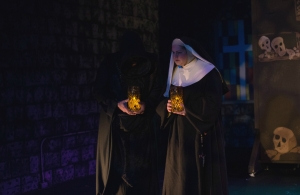
Tom Lodge and Kathryne Daniels. Credit: Tessa Sollway
Lighting Design by Charles Danforth III does more than light the actors on stage but sets the mood completely for each scene. Whether outside in a courtyard or in an underground tunnel, the lighting scheme matches the action and setting. Danforth’s design blends in with the action and is absolutely appropriate for the piece.
To go along with Lighting Design, Andrew Porter’s Sound Design is on point for this production. Though there are not a lot of sound effects in this production, what is utilized is definitely befitting. Namely, the realistic “dripping water” sound effect used in the underground tunnel setting adds value to the scene and the production.

Steven Shriner and Anne Shoemaker. Credit: Tessa Sollway
The use of recordings is wise and is hilarious as the actors blatantly lip-sync through an entire number, skipping and dancing as they do. It’s worthe mentioning the song in the the courtyard between Mother Superior and Agnes is not only hilarious with the afore mentioned lip-syncing and skipping, but has beautiful vocals by actresses Holly Gibbs and Anne Shoemaker, with guitar by David Shoemaker.
Costume Design by Anthony Lane Hinkle and Mary Bova (of A.T. Jones) is authentic and fun for this piece. Set in the mid 1960s, styles and fashion were flashy and all over the place, but Hinkle and Bova manage to capture the essence of the 60s with their Costume Design. The nuns, of course, are your traditionally dressed 1960s nuns with the full habit and rosarary and the actors seemed very comfortable in these genuine-looking habits, moving freely about the stage. Outside of the nun costumes, the “civilian” character costumes were equally as impressive. The many costumes of the character named Mrs. Levinson, were all on point and fitting of the character and time, with polyester looking material and vibrant colors of a wealthy middle-aged woman with a penchant and propensity for current fashion and haute couture. Kudos to Hinkle and Bova for their impeccable design.
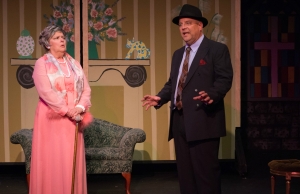
Lynda McClary and Tom Lodge. Credit: Tessa Sollway
Steve Goldklang’s Direction of this piece is impressive and concise as his vision for this very funny and upbeat piece is clear making for a very well put-together production. Goldklang seems to understand this story is not merely making fun of any particular religion but using humor to tell a story and send an important message of trust and belief.
Though I don’t consider The Divine Sister a traditional farce, it does have farcical aspects and quick entrances and exits, but, overall is just a very witty comedy that Goldklang understands and keeps that delicate balance of mocking and poking fun. He keeps the action moving and, aside from the lengthy scene changes, manages to use the immense talents of his cast to keep the stor
y moving forward. Overall, Steven Goldklang does an outstanding job at the helm of this production.

Kathryne Daniels as Sister Walburga. Credit: Tessa Sollway
Moving on to the performance aspect of this piece, Kathryne Daniels as Sister Walburga/Mrs. Macduffie has a great look and command of the stage making both her characters interesting and entertaining. Her characters are completely different and Sister Walburga as the stern Sister from Berlin may not be all she seems while Mrs. Macduffie, the cleaning lady, seems to know everything that’s going on in their little circle and is happy to share her information. It seems Daniels is the only actor required to use accents for her characters (German for Sister Walburga and Scottish for Mrs. Macduffie) but she may have benefited by working with a dialect coach as her accents for both characters were a dicey, at best. Regardless, her performance was impressive and she seems to understand her characters and plays them beautifully.
Tom Lodge as Brother Venerius/Jeremy is likable and carries the weight of being the only male character in the entire piece. He is comfortable and confident onstage and his portrayal of Jeremy is believable and moves the story along through his dialogue, making him an involved character. However, for as good as he portrays Jeremy, his portrayal of Brother Venerius, whose face we never see, falls a little flat. Brother Venerius is a mysterious character lurking in the underbelly of the convent but I couldn’t pinpoint where is character is supposed to be from as the accent he chooses to use is all over the place and a little strange. Overall, Lodge gives a very strong performance and carries his characters quite well.

Holly Gibbs as Sister Acacius and Lynda McClary as Mrs. Levinson. Credit: Tessa Sollway
Holly Gibbs is brilliant as Sister Acacius a.k.a. Lily in this production of The Divine Sister. She has great comedic timing and her understanding of the character is apparent as she pulls off the New York accent and mannerisms impeccably. As a nun who’s going through some things, including not necessarily wanting to be a nun anymore, and has an interesting past along with Mother Superior, Gibbs plays the role with the right amount of humor and is absolutely believable as Sister Acacius, the right hand man to Mother Superior. Gibbs never disappoints and her work in this production is no different.

Kathryne Daniels, Anne Shoemaker, and Holly Gibbs. Credit: Tessa Sollway
Anne Shoemaker as Agnes, the postulate who is having visions and healing the sick, is a standout in this production. Her comedic timing is on point and her character choices are impeccable. She plays this role with the perfect amount of “crazy” that is required for this character. A cross between Maria Von Trappe and Annie Wilkes (from Stephen King’s novel Misery), Shoemaker finds a perfect balance of innocence and insanity for this character and her depiction of the transition her character goes through is also admirable, In general, Shoemaker is confident and commanding and gives a strong and impressive performance.
Lynda McClary as Mrs. Levinson/Timothy is hands down one of the highlights of this production. With that being said, in the role of Timothy, the young man who is bullied and not the best athlete, along with other adolescent issues, McClary is a bit much. An adult actor playing a child is always tricky and, for this production, McClary takes it to the extreme to being almost annoying, rather than funny, but, if anything, she is absolutely dedicated to the role, giving 100%. Her portrayal of Mrs. Levinson, however, is a completely different story. Mrs. Levinson is the wealthy, fashionable, and philanthropic widow who has secrets of her own and McClary pulls this role off flawlessly. With just the right balance of snootiness and humility, she is a riot with immaculate comedic timing and is an actress who isn’t afraid to make a fool of herself for the good of the production. She’s a seasoned actor and her confidence and command of the stage makes for a funny and outstanding performance.
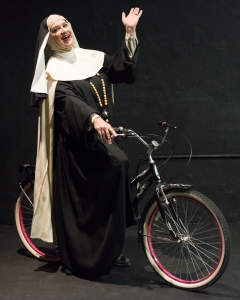
Steven Shriner as Mother Superior. Credit: Tessa Sollway
Last but certainly not least is Steven Shriner as Mother Superios a.k.a. Susan who is another absolute highlight of this production. For some reason, a man in drag is still funny after all the years of it being a bit in show business and this production is no different. Shriner is superb as Mother Superior and his delivery of the clever lines and his timing is just about perfect. The success of his performance is the character of Mother Superior seriously, not as a mockery, and it makes for a very strong, funny, natural performance. His soothing voice and mannerisms make for an authentic portrayal and a very likable character. As both Mother Superior and Susan, the young and sweet, but cut-throat New York reporter, Shriner gives a confident and commanding performance and I’m looking forward to seeing more from him.
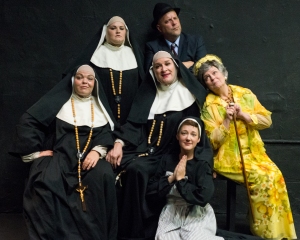
The Cast of The Divine Sister. Credit: Tessa Sollway
Final thought… The Divine Sister at Fells Point Corner Theatre is witty, hilarious show with a clever script and excellent performances from the ensemble. The piece pokes fun at religion but certainly does not mock it and, in the end, sends a good message of faith and hope through crafty humor that will have your sides splitting. Get your tickets now! You don’t want to miss this one!
This is what I thought of Fells Point Corner Theatre’s production of The Divine Sister. What did you think? Please feel free to leave a comment!
The Divine Sister will play through December 18 at Fells Point Corner Theatre, 251 S Ann Street, Baltimore, MD. For Tickets, go to fpct.org for information or purchase them online.
Introducing BACKSTAGE BITS, a backstage look into the shows we review!
 In an effort to continuously evolve and grow, Backstage Baltimore is introducing a new vlog called BACKSTAGE BITS! Backstage Bits will feature short one-on-one interviews with the casts and crews of the productions we review to give an even deeper look into the artsy scene in and around Baltimore.
In an effort to continuously evolve and grow, Backstage Baltimore is introducing a new vlog called BACKSTAGE BITS! Backstage Bits will feature short one-on-one interviews with the casts and crews of the productions we review to give an even deeper look into the artsy scene in and around Baltimore.
Please take a moment to click the link below to check out our inaugural BACKSTAGE BITS, featuring the insanely talented and fun cast of the Helen Hayes Award Recommended EVIL DEAD THE MUSICAL, that recently ran at Red Branch Theatre Company this past October!
BACKSTAGE BITS, Episode 1: EVIL DEAD THE MUSICAL at Red Branch Theatre Company
Also, check out our BACKSTAGE BITS, featuring the cast and crew of THE 25TH ANNUAL PUTNAM COUNTY SPELLING BEE at Heritage Players, running until November 20!
BACKSTAGE BITS, Episode 2: THE 25TH ANNUAL PUTNAM COUNTY SPELLING BEE at Heritage Players
Thanks so much for your support and enjoy!
New Backstage Banter for The Roommate at Everyman Theatre
Click here to check out the Backstage Banter for The Roommate at Everyman Theatre!
“A coming-of-age story about two middle-aged women? Yep! That’s right! Much like a modern day Odd Couple, these two characters couldn’t be more different but have so much to offer each other, whether they know it or not.”
Everyman Theatre
Review: The 25th Annual Putnam County Spelling Bee at Heritage Players
By Jason Crawford Samios-Uy

Running Time: 2 hours with a 15-minute intermission
It’s been repeated through the ages – being a kid isn’t easy! If you can remember (and most of us can), the world is a completely different place for a kid and Heritage Players latest offering The 25th Annual Putnam County Spelling Bee, Directed by Ryan Geiger, with Music Direction by TJ Lukacsina and Robin Trenner and Choreography by Jose Reyes Teneza, takes us right back to that crazy time when changes in body, mind, and viewpoints were happening and every day was a struggle… then the bastards throw something like a spelling bee in the mix to pit us against each other!

Chip Tolentino (Charlie Roberts) at the mic as the rest of the cast looks on. Credit: Heritage Players
Walking into the Rice Auditorium at Spring Grove is a treat! It’s bright, neat, and clean and it’s a space that lends itself nicely to community theatre! Ryan Geiger, who takes on double duty as Director and Set Designer uses the traditional setting (a school gymnasium) for this production and, liking traditional theatre as I do, I thought it worked very nicely. It was a minimal set but Geiger’s attention to detail is on point and large printouts of a scoreboard and sports banners are clever and give the set a neat, precise look. This is a unit set show with movable set pieces and every piece had a purpose and helped tell the story.
Lighting Design by TJ Lukacsina and Sound Design by Stuart Kazanow is appropriate and sets the mood for this quirky piece. Notably, there is a very neat effect concerning the Taj Mahal that is very clever and quite effective.
Sound is always a challenge for small theatres depending on the space and what the space is originally intended for. Kazanow’s Sound Design for this production is good, but seems a bit muted, slowing down the action onstage. Again, this could be because of venue and, overall, Lighting and Sound are respectable.

William Barfee explains his “Magic Foot” as the rest of the cast joins in. Credit: Heritage Players
The 25th Annual Putnam County Spelling Bee is an eccentric kind of show where there’s a lot of music but it doesn’t call for a ton of choreography. However, Choreography by Jose Reyes Teneza fits in nicely. There are only a few big group numbers including “Magic Foot” and “Pandemonium” but the choreography is creative and tight and the cast seems to be having a great time with it.
Music Direction by TJ Lukacsina and Robin Trenner is impressive with great solo numbers and harmonic ensemble numbers that are on point and well-rehearsed. For being a fun, breezy show, Spelling Bee does, in fact, have some complex harmonies, but these were handled beautifully under the direction of Lukascsina and Trenner.
Going along with Music Direction, the orchestra is worth mentioning, giving a commendable performance with Robin Trenner on Piano, Ellie Whittenberger on Synthesizer, David Booth on Reeds, Ina O’Ryan and Juliana Torres on Cello, and Mykel Allison on Drums.

The spellers take center stage. Credit: Heritage Players
Taking on double duty as both a character in the production and Costume Designer, Stephen Foreman hit the nail on the head with these costumes. The costume design follows the original Broadway production’s scheme, for the most part, and his eye for detail is impressive. All of this actors seems comfortable in their wardrobe and the well though-out, meticulous costumes definitely add great value to this production.
Being a first time director has its own set of challenges but being a first time director for a musical is something entirely different. However, Director Ryan Geiger does a fantastic job with this piece, understanding its humor and its poignancy in a very balanced production. His casting is superb and his vision is clear, seeing life through the eyes of some very anxious, over-achieving kids in competition with each other and trying to discover themselves in the process. Kudos to Geiger for a job well done on his inaugural production as a director.

The cast. Credit: Heritage Players
Moving into the performance aspect of this piece, I have to say the ensemble, as a whole, is outstanding. Audience participation is the name of the game for this show and the ensemble works with the participants brilliantly. The seemingly random audience members who are asked to participate in the bee seem to have a great time with this ensemble and the ensemble assures each audience member is at ease during the performance. The chemistry is crystal clear, the harmonies are flawless, and the dancing is tight and concise. Every one of these actors is giving 100% and seem to be having a blast onstage, which, in turn, brightens the mood of the audience.

Marcy Parks (Kristi Dixon) explains her many talents, backed up by the girls. Credit: Heritage Players
Kirsti Dixon’s Macy Park is staunch and uptight, as the character calls and her number was upbeat and energetic. Though Dixon may have slight issues with the higher register of her number, “I Speak Six Languages,” her character is near perfect and she gives a strong, confident performance.
Matt Scheer tackles the role of Mitch Mahoney, the rough and tough, ex-con Comfort Counselor who’s job it is to give the kids a hug and juice box when they’ve been eliminated. Scheer plays the role as more of an 80s metal-head throwback rather than the original gruff, leather jacket and chains wearing character. Still, this character works nicely and he’s comfortable in the part and has a strong, booming voice for his number “Prayer for the Comfort Counselor” that is a fitting finale for the first act.

Logainne Schwartzandgrubinierre (Libby Burgess) tries to describe her strife as her dads discuss behind her. Credit: Heritage Players
Logainne Schwartzangrubenierre, played by Libby Burgess, is an over-over-achiever pushed by parents who want what’s best for her, but might not see the burden it puts on her young, frail shoulders. Burgess tackles this role beautifully and her character is strong. The anxiousness and nervousness come out in her performance and she seems to really understand this poor kid. She’s comfortable on stage and has great chemistry with Zach Roth and Richard Greenslit, who play her two fathers.
Charlie Roberts takes on the role of Chip Tolentino, the “alpha male” of the group and the winner of last year’s Spelling Bee. Roberts certainly looks the part in his clean cut Boy Scouts uniform but his portrayal of Tolentino falls a bit flat. Overall, he did a fine job with his performance, choreography, and songs, but I want his character to be a little more forceful and less delicate. His featured numbers “Pandemonium” and “Chip’s Lament” was performed nicely, but may have been a little too high for his register. However, he’s confident and comfortable onstage and gives a commendable performance.
William Barfee, the obnoxious, know-it-all, and probably the keenest speller in the Bee, is played by Stephen Foreman who does a good job pulling this character together. His comedic timing is very good, though some of the jokes could be milked just a tad bit more as he tends to skim by them at times and, dare I say it, he could be just a bit more obnoxious as it’s what’s funny about this character. His number, “Magic Foot” is performed well and confidently and he seems comfortable and his look is spot on for this role.
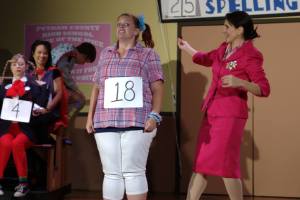
Kristen Zwobot as Olive Ostrovsky. Credit: Heritage Players
Kristen Zwobot as Olive Ostrovsky is definitely reaching in for her inner child for this role. She’s believable in the role and captures the awkwardness of a young girl with separated parents who may be too smart for her own good. She seems to get this character and doesn’t play her with pity but with compassion. Her numbers, “My Friend the Dictionary” and “The I Love You Song” (a trio with Rachel Weir and Matt Scheer), are touching and she performs them well with a strong, confident voice.

Zach Roth as Leaf Coneybear. Credit: Heritage Players
Among the “child” characters, Zach Roth as Leaf Coneybear is definitely a highlight. His character is different from the other characters in that he’s really in it for the fun, not the competition. His innocence and naiveté makes you feel for him and root for him and he pulls the character off with ease. He’s comfortable in the role and his comedic timing is top-notch. He keeps his character interesting and makes a connection with the audience. Kudos to Roth for an admirable performance.
Rachel Weir portrays Rona Lisa Peretti, one of the three adult characters in this show and one of the moderators of the Bee as well as a former winner. Weir is also a highlight in this production in this role as she embodies this character heart and soul. It isn’t hard to believe this woman is a adamant fan of spelling and of spelling bees and that, deep down, she does care for this kids and wants them to succeed because she had been in their shoes at one time. Weir has an absolutely beautiful voice that resonates throughout the auditorium in songs such as her “Favorite Moment” songs throughout the production explaining how the bee actually works. She acts this character flawlessly and has a strong confident presence making her a joy to watch.
Richard Greenslit as Douglas Panch is the standout in this production of The 25th Annual Putnam County Spelling Bee. As Douglas Panch, Greenslit has impeccable comedic timing and doesn’t take his character too seriously making for a phenomenal performance. He had me at stitches with his delivery of some of the definitions and sentences for some of the words in the bee. His chemistry with his cast mates is excellent and he seems to have a grasp on the purpose of this character which makes him quite believable in this role. He’s comfortable with a very strong stage presence and gives a performance that knocks it out of the park.

Matt Scheer as Mitch Mahoney and the Cast. Credit: Heritage Players
Final thought… The 25th Annual Putnam County Spelling Bee at Heritage Players is an entertaining and funny show to which mostly everyone can relate. We’ve all had that crazy time in life where changes were happening and things we don’t find so important today were life or death situations. It’s easy to relate to these characters and see a little of ourselves in each of them. If you want a fun show to check out, get your tickets now!
This is what I thought of Heritage Players production of The 25th Annual Putnam County Spelling Bee. What did you think? Please feel free to leave a comment!
The 25th Annual Putnam County Spelling Bee will play through November 20 at The Heritage Players, Rice Auditorium at Spring Grove Hospital Center, 55 Wade Avenue, Catonsville, MD. For Tickets, email heritageplayerslive@gmail.com or purchase them online.
Review: Cabaret Macabre: The Return Visit from Happenstance Theatre at Baltimore Theatre Project
By Jason Crawford Samios-Uy

Running Time: 1 hour and 10 minutes with no intermission
The autumn brings out crazy things in people. Harvest moons, Halloween, a chill in the air – it all leads to a certain, feeling. Some would say “macabre,” which is defined by Merriam-Webster as “involving death or violence in a way that is strange, frightening, or unpleasant.” The latest offering from Happenstance Theatre at Baltimore Theatre Project, Cabaret Macabre: The Revisit, is just that… so much so it’s in the name! There’s just something off-kilter about this spooky, but clever cabaret that you have to see to understand completely.
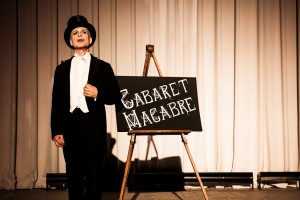
Credit: Happenstance Theater
The space itself has been transformed into a simple dark, black space that reminded me of a side show tent where you can pay a shiny dime to look at the freaks, except there are no freaks here – just a talented, just left of center acting troupe called Happenstance Theatre. The billowing black curtains complement the high ceiling and blank stage, and the entire set is likened to a Tim Burton movie, dark and creepy but with a hint of anticipation as to what lurked behind those curtains.

Credit: Happenstance Theater
Lighting Design by Kris Thompson is spot on and minimal, but superb for this production. Once the house lights go down, the dim lighting throughout the production add to the creepy feeling and the precise lighting design complement the performance rather than inhibit it. Along with the set, the lighting sets the perfect mood for this macabre piece.
Costumes are certainly a highlight of Cabaret Macabre: The Return Visit. Each costume is on point with great attention to detail. Costume Design by Sabrina Mandell is to be commended as the mainly black and white color scheme is consistent throughout and the costumes are well though-out, superbly designed, and quite appropriate. The actors seem to be very comfortable in their many costumes and they certainly add to the creepy theme of this production. Kudos to Mandell on a job well done
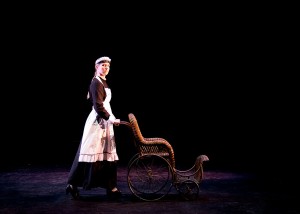
Credit: Happenstance Theater
Music played a major role in this production and the choices made by Composer/Arranger Karen Hansen are outstanding. Her talent is well apparent as, throughout the production, she plays the piano, an organ, a tuba-looking instrument, an upright viola, a double trumpet, and a lyre or something that looked like one. Moving back and forth from one side of the stage to the other, she performed with ease and comfort, displaying her musical prowess. Hands down, she is a brilliant musician and handles her role very well.
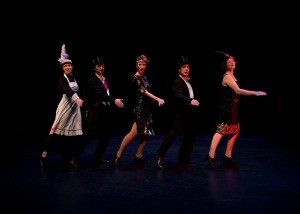
Credit: Happenstance Theater
Being a true ensemble piece, no Director is noted but it seems all the performers – Gwen Grastorf, Karen Hansen, Mark Jaster, Sabrina Mandell, Sarah Olmsted Thomas, and Alex Vernon – has a hand in creating these creepy vignettes. Mostly pantomime with very little dialogue, each act was very well-rehearsed and got the point across through movement, which is quite impressive. All of the actors were very comfortable on the stage and all worked together like a well-oiled machine. Quirky comedy and making light of unfortunate events bring a dark comedy feel to this piece and it fits like a glove. This is truly and ensemble piece and each actor blends in beautifully, knowing his or her role, and performing it flawlessly to create a well put-together piece.
One act worth mentioning is an Apache Dance choreographed by Sarah Olmsted Thomas that portrays a violent encounter between a couple who seem to hate each other but can’t stand to be apart. The elegance and passion in the number is clear and very enjoyable to watch.
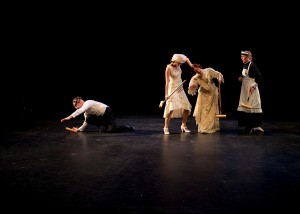
Credit: Happenstance Theater
Another comedic act that is a standout is Rules of Croquet, which is another hilarious pantomime with the unfortunate demise of everyone involved. The physicality, creativity, and discipline in this piece is very impressive and makes it a certain highlight of the entire production.
Final thought… Cabaret Macabre: The Return Visit isn’t just your run of the mill production but a collection of Edward Gorey inspired Victorian nightmares that seem a little off kilter, but you don’t know exactly why. The ensemble performs the work beautifully and the entire experience puts you in the mindset of an old-time cabaret where there is no program to follow and each act is a surprise. Perfect for this time of year, the tragic beauty of this production is worth checking out!
That’s what I thought about Cabaret Macabre: The Return Visit. What did you think? Please feel free to comment below!
Cabaret Macabre: The Return Visit presented by Happenstance Theatre will play through November 13 at Baltimore Theatre Project, 45 W. Preston Street, Baltimore, MD. For tickets, call the Baltimore Theatre Project Box Office at 410-752-8558 or purchase them online.
Review: Halmet Lost/Found at CCBC Academic Theatre
By Jason Crawford Samios-Uy

Running Time: 1 hour and 30 minutes with no intermission
It’s interesting to think that a play that is over 400 years old can still be relevant today but, most of The Great Bard’s stories are timeless and still quite relevant in the 21st century. Hamlet Lost/Found, Directed by Julie Lewis with Set and Lighting Design by Moe Conn, Costume Design by James Fasching, and Original Music Composition by Daniel Lewis is currently playing at CCBC Academic Theatre on the Catonsville campus is not only relevant, but is updated just enough to easily understand the story of guilt, betrayal, revenge, and unmitigated human nature.
In academic theatre, students are learning and teachers are teaching, but sometimes we forget how talented these students and teachers actually are. Walking into the Center for the Arts Theatre on the Catonsville campus of CCBC, I was treated to a well-thought out, well-designed set by Set Designer Moe Conn. The different levels kept the set interesting and the black and white and modern motif kept it simple, yet elegant. The surprising transition of the set, opening up for a larger stage, keeps the story moving and intriguing for the audience. Conn uses his space wisely and adds value to this updated version.
[youtube https://www.youtube.com/watch?v=NdbS2j0wJUw&w=560&h=315]
To go along with Set Design, Conn took on the responsibilities of Lighting Designer, as well, and his design is absolutely appropriate and sets the mood for each scene. In the adapted, more updated portion of the story, Conn’s lighting of the “night club” is authentic, fun, and just enough, adding to the story rather than making it a spectacle. Kudos to Conn for his work on Set Design and Lighting Design.
Costume Design by James Fasching is brilliant, matching the set with a black and white and modern style. His choices for each character is very appropriate and quite fashionable and the all of his actors seem very comfortable in their wardrobe. Since this is not a traditional mounting of this story, Fasching has managed a chic and elegant Costume Design that is well thought-out and fits nicely with the piece.
Music has always played a key role in Shakespearian productions and for this production, Daniel Lewis was charged with composing original pieces and he knocks it out of the park. His compositions are contemporary, fun, and complex, yet very appropriate for this updated version and quite enjoyable to hear. All of the pieces are placed nicely in the piece and add great value to this production.
Shakespeare can be challenging, even if one is familiar, so every now and then, a piece is updated for a contemporary audience and updating and adapting can be a little tricky, too. Director Julie Lewis, Tatiana Fish, and the ensemble, however, do a superb job with the adaptation of this piece. The first half of this production is presented with traditional text and the second half is performed with the adaptation. First and foremost, this careful adaptation makes it easier to understand the story and throws a bit of humor into this tragedy making it more accessible to a contemporary audience. Lewis also keeps her actors moving on stage giving the piece a nice tempo and flow. Her casting of these complex characters is very good and, at times, non traditional, making for a riveting production. Lewis clearly has a deep understanding of this timeless story and her vision is apparent, relating to current times and ideologies. Major kudos to Julie Lewis on a job well done.
Aside from the outstanding production aspect of this piece, the performances are also commendable and the ensemble is on point in telling this story. All of the members of the cast worked well together and had a great chemistry. Together, they created an entertaining, polished piece of which they should be proud.
A few honorable mentions go to Tirrell Bethel as the King Hamlet’s Ghost, Lloyd Ekpe as Claudius, Molly Prunty as Guildenstern, and Randi Seepersad as Rosencrantz. Bethel exudes just the correct amount of creepiness as he dictates the actions of his son from the dead while Ekpe plays the sly, cunning uncle and replacement of King Hamlet with the appropriate amount of sleaziness and guilt for his deplorable actions. Prunty and Seepersad work well together as Guildenstern and Rosencrantz, respectively, the hesitant spies and friends of Hamlet. The chemistry of these two actresses and the humor they express in the roles make them a joy to watch. Overall, the entire ensemble did a stellar job presenting this story.
A few standouts are Alajandro Mendez as Hamlet, Elizabeth Armour as Palonia (usually Palonius), Jake, Urtes as Horatio, and Ja’min Williams as Laertes.
Alajandro Mendez’s Hamlet is filled with emotion and tragedy and he seems to understand the inner turmoil and rage of his character. He is comfortable on stage and has a great presence making for a very good performance.
Elizabeth Armour is a very confident actress, portraying Palonia as the social climber she is but playing it with grace and dignity. She a character you love to hate which goes to show how accurate her performance is in this production.
As Horatio, Jake Urtes is certainly one of the highlights of this production. He’s very natural and tackles the Shakespearian text with ease and a comfortable rhythm. He’s easy to understand and he seems to grasp his character and plays him with the loyalty to Hamlet that is required. He’s confident and comfortable and gives a very strong, entertaining performance.
Another highlight is Ja’min Williams as Laret
es (and an Actor) and he, too, is very comfortable and confident in this role and finds his rhythm easily. His portrayal of Laretes and an Actor is authentic and natural and he is a joy to watch. He moves with purpose and gives a powerful performance.
Final thought… as each year passes, Shakespeare can be a tough pill to swallow. However, CCBC Academic Theatre’s production of Hamlet Lost/Found gives you a half and half – half traditional text and half updated and modernized text making it much easier for a contemporary audience follow the tragic story. The adaptation is a win and if you are familiar with Shakespeare’s Hamlet, you will not be deterred and if you are unfamiliar, this production will give you a better understanding of this popular tragedy.
That’s what I though of Hamlet Lost/Found. What did you think? I’d love to hear it! Feel free to leave a comment!
Hamlet Lost/Found will play through November 7 at The Community College of Baltimore County, Catonsville Campus, Center for the Arts Theatre. For tickets, call the box office at 443-840- ARTS (2787) or purchase them online.
Review: Always Patsy Cline at Dundalk Community Theatre
By Jason Crawford Samios-Uy

Running Time: 2 hours with one 15-minute intermission
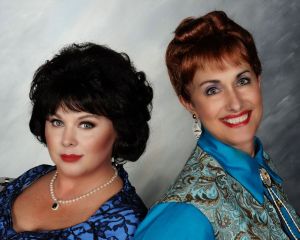
Tiffany Walker Porta Burrows as Patsy Cline and Maribeth Vogel as Louise Seger. Credit: Dundalk Community Theatre
Jukebox musicals can be a tricky entity, but Dundalk Community Theatre’s current production, Always Patsy Cline, Directed by Eric Potter seamlessly stitches together old Patsy Cline songs to create a delightful piece of nostalgia. With Music Direction by Charlotte Evans, Costume design by Larry Munsey, and Set, Lighting, and Sound Design by Marc W. Smith this production is near flawless and brings the iconic Patsy Cline back to life for an evening of pure country music and a glimpse into a fan’s dream come true.

Tiffany Walker Porta Burrows as Patsy Cline and Maribeth Vogel as Louise Seger. Credit: Dundalk Community Theatre
Walking into the John E. Ravekes Theatre, I was transported to a bygone era and the original Grand Ole Opry at the Ryman Auditorium. Veteran Technical Director Marc W. Smith’s Set Design is exquisite and downright accurate with a painted barn and bandstand. Smith’s attention to detail is also apparent in the other two smaller settings of a Texas dance hall with tables and a jukebox and a small 1960s kitchen with an old Frigidaire and pastel colored dishes. All of his sets are authentic and well designed adding great value to this production.
Smith also takes on the duties of Lighting & Sound Design which compliments the Set Design nicely. His Lighting Design is simple, yet sets the mood for each number and is antithetic for each setting, giving a clear separation. The design is well thought-out and executed beautifully.
Being a musical, Sound Design must always be handled delicately, finding a balance between the orchestra or band and the actors who are singing. Smith’s design finds this balance for a brilliant sound throughout the production.

Tiffany Walker Porta Burrows as Patsy Cline and Maribeth Vogel as Louise Seger. Credit: Dundalk Community Theatre
Costume Design by Larry Munsey is superb, matching many well-known Patsy Cline costumes and style. Putting an actress up on the stage to play a real person is difficult, but Munsey’s costume choices are impressive. He not only costumes Ms. Cline well, his design for the other character, Lois, is also well-thought out, creating a down-to-earth, friendly 1960s Texas gal who likes to have a good time. Did I mention hair? Well, the hair was very authentic for both Patsy Cline and Lois, with their bouffants and high dos. Kudos to Munsey on his authentic and fun Costume Design.
Most of the songs presented in Always Patsy Cline are well known Cline hits, including “Back in Baby’s Arms,” “Walkin’ After Midnight,” “I Fall to Pieces,” and “Crazy.” Music Director Charlotte Evans does a superb job bringing these songs back to the stage and has the band swinging with the upbeat numbers and keeping a steady beat for the ballads and even providing vocal backup where needed. It’s always difficult with a jukebox musical because, these are the songs folks are accustomed to hearing certain way and Evans does not disappoint. All of the numbers sound like the original recordings and the band, consisting of Charlotte Evans on Piano, Corey Chubb on Electric Guitar, Randy Austin, Jr. on Sleep Lap Guitar, Greg Bell on Bass, Alani Sugar on Fiddle, and Joe Pipkin on Drums produce a good old fashioned honky tonk, rock-a-billy sound.

Tiffany Walker Porta Burrows as Patsy Cline and Maribeth Vogel as Louise Seger. Credit: Dundalk Community Theatre
Directing a biographical piece can be challenging but Director Eric Potter seems to have tackled this challenge to create a successful and nostalgic piece giving a little insight into Cline through stories told by a fan-turned-friend in the late 50s through the rest of Cline’s life. Potter’s vision is clear as he presents Patsy Cline as the absolute star she was. He keeps the action moving nicely, giving the story a good flow, and the transitions from one song to the next is seamless. His understanding of the script and subject matter is apparent and his production does not mock, but celebrates the life of this gone-to-soon icon.

Tiffany Walker Porta Burrows as Patsy Cline. Credit: Dundalk Community Theatre
As for the performance of this piece, Tiffany Walker Porta Burrows as Patsy Cline and Maribeth Vogel as Lois Seger are forces of nature on the stage and bring Patsy Cline back to life with gusto and respect.
Though portraying a once living, famous person can be quite difficult, Tiffany Walker Porta Burrows is a standout as Patsy Cline and really understands her character. Her voice is as impressive, smooth, and clear as the real Patsy Cline and she is comfortable and confident with each and every song. Though Cline was a country music superstar, it’s reported she was very down-to-earth, as well, and Burrows portrays this brilliantly in her scenes with Maribeth Vogel, with whom she has a great chemistry and ease. She gives a very strong performance and is believable with every step and every note she sings.

Maribeth Vogel as Louise Seger. Credit: Dundalk Community Theatre
Maribeth Vogel as super-fan Lois Seger is likable from the moment she steps on stage. Vogel expresses her affection and love for Cline clearly and gives such a natural performance that makes me feel like she’s my next door neighbor telling me the story of her encounter with her idol. She is very comfortable interacting with the audience, as she does throughout the performance, and she sets the audience at ease. She has a strong presence onstage and her comedic timing is on point, making for a very successful and delightful performance.
Final thought… Patsy Cline is an undisputed icon in the entertainment industry and her legacy must be handled delicately but Dundalk Community Theatre manages to bring her back to life with grace, dignity, and a bit of humor. If you’re a Patsy Cline fan, as I am, you will not be disappointed and if you are unfamiliar with this velvet-voiced songstress, this production would be the perfect introduction.
Have a different viewpoint? What did you think? We’d love to hear from you! Feel free to comment below!
Always, Patsy Cline will play through November 6 at The Community College of Baltimore County, Dundalk Campus, John E. Ravekes Theatre. For tickets, call the box office at 443-840-ARTS (2787) or purchase them online.
Review: The Roommate at Everyman Theatre
By Jason Crawford Samios-Uy

Running Time: 1 hour and 30 minutes with one 15-minute intermission
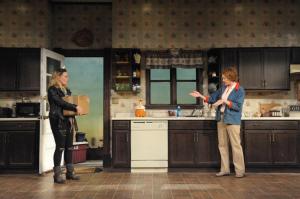
Beth Hylton as Robyn & Deborah Hazlett as Sharon. Credit: Photos by Stan Barouh
I suppose once we’ve settled into a way of life, we’re all a little afraid to rock the boat and, God forbid, start over. The latest offering from Everyman Theatre, the East Coast debut of The Roomate by Jen Silverman and Directed by Johanna Gruenhut, gives us a glimpse into what could happen if that’s what a couple of middle aged ladies must do. A coming-of-age story about two middle aged women? Yep! That’s right! Much like a modern day Odd Couple, these two characters couldn’t be more different but have so much to offer each other, whether they know it or not.
Though the story is a little predictable, as it has been told many times before, it still holds a certain charm and a slight twist at the end that I was not expecting. It’s simply a story of self-discovery and stepping out of your comfort zones and the production at Everyman Theatre is smart, modern, and poignant.
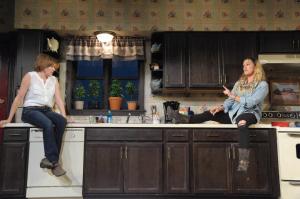
Beth Hylton as Robyn & Deborah Hazlett as Sharon. Credit: Photos by Stan Barouh
Everyman has always impressed with their sets and The Roommate is no exception. Set Design by Timothy R. Mackabee is striking and authentic. Much like the Midwestern state in which the play takes place, the set doesn’t have too many level but is flat and expansive as Iowa itself. The details are impeccable from the running water to the magnets on the old refrigerator and makes one feel “at home” as if they were sitting in their own kitchen. Though there is more than enough cabinet space, there’s not much in the way of furniture (other than kitchen appliances and a kitchen table and chairs), and the stage is very maneuverable making for a very good flow to the action. There aren’t a lot bells and whistles but it’s simply a very quaint, almost boring kitchen that actually makes this set design near perfect and absolutely appropriate.

Deborah Hazlett as Sharon. Credit: Photos by Stan Barouh
Lighting Design by Jesse Belsky for The Roommate is nothing short of flawless. When it comes to a play, technical subtleties really make or break a production and Belsky hit the nail on the head. The use of lighting to distinguish morning, afternoon, and evening is stunning and I could tell exactly what time of day it was simply from the lighting. Working with the set and casting shadows all over the stage gives the design a very realistic and cinematic vibe that works well with this piece. Both interior and exterior lighting is spot on and sets the mood for each scene. The design is well thought out and adds significant value to this production.
I must take a moment to mention the phenomenal Sound Design by Stowe Nelson. Nelson’s impressive work is a definite technical highlight for this production. Somehow, Nelson manages to play with the sound and the acoustics in a way I haven’t seen, yet, on the Baltimore stage. Notably, he magically takes a localized sound cue (a radio or record player) that’s playing in a corner of the stage, as part of the scene, and gradually throws it into the audience over the PA system, filling the entire theatre. Mostly used during transitions, this “trick” gives the feeling of watching a film on the silver screen rather than sitting in a theatre with live actors. Major kudos goes to Stowe Nelson for his outstanding design.

Beth Hylton as Robyn & Deborah Hazlett as Sharon. Credit: Photos by Stan Barouh
The Roommate is set in present day and Costume Design by Sarah Cubbage was well thought-out and appropriate for the characters. Displaying their polar opposites, Cubbage’s choices are very clever, matching a leather jacket, jeans, and boots on one character to a more conservative, blouse, slacks, and flats on the other. The two different wardrobes complement each other very nicely and express the differences the two ladies have.
Director Johanna Gruenhut is to be commended for her work on this piece. She really seems to understand the story and gets her actresses to tell it convincingly. It’s sometimes difficult to keep up the humor in a serious piece, but Gruenhut manages to keep everything light and breezy while not taking away from the emotional soul of the piece. She keeps the action moving smoothly onstage with her smart blocking and the transitions are seamless. Gruenhut presents a well though-out and beautifully cast piece.

Beth Hylton as Robyn. Credit: Photos by Stan Barouh
Moving into the performance aspect of The Roommate, Beth Hylton, an Everyman Theatre Resident Company member, gives an thoughful and heartfelt performance as Robyn, the somewhat crass uprooted Brooklyn native trying to find her way through a very different Iowa. She brings an appropriate edginess to this character that fits wonderfully. Though, at first glance, I couldn’t believe she was a middle-aged woman, I quickly realized she’s not playing the stereotypical middle-aged woman, but a confident, independent woman who sees age as just a number. She’s very comfortable on the stage and with this character and seems to understand the inner turmoil her character is experiencing and she has a complete grasp on the reasons her character is so mysterious making for an enjoyable and commendable performance.
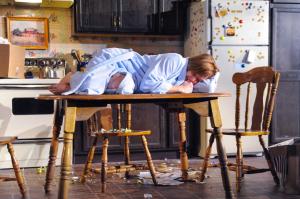
Deborah Hazlett as Sharon. Credit: Photos by Stan Barouh
Deborah Hazlett, another Everyman Theatre Resident Company member, gives an outstanding performance tackling the role of Sharon. Her authenticity shines through from the moment she sets foot on stage and she really has a grasp of her character, a Midwestern middle-aged divorcee. Her comedic timing is on point and the gradual transition of her character is presented flawlessly. She has a commanding stage presence and moves comfortably and with purpose throughout the production. Though both characters are changed by the end of the story (which is inevitable for these types of characters in this type of show), Hazlett’s character has the greatest change and she pulls it off with great emotion mixed in with just the right amount of comedy.
The naturalism these two actresses have bring the audience into the story and make these characters accessible. It’s easy for the audience, both men and women, to find aspects of each character to which they can relate making for a very gratifying evening of theatre.
Final thought… The Roommate is a funny, yet poignant tale of starting over and discovering new things about the world and yourself when you think your life and the world is just about over. Self-realization and change can come at any time and when you least expect it, you just have to be open to it. This production at Everyman Theatre is worth an evening of your time and, who knows? You may discover one or two things about yourself!
That’s what I though. What do you think? Feel free to leave me a comment below!
The Roommate will play through November 27 at Everyman Theatre, 315 W. Fayette Street, Baltimore, MD. For tickets, call the box office at 410-752-2208 or purchase them online.
